Bathroom Remodel Contractors: Your Guide to a Successful Project
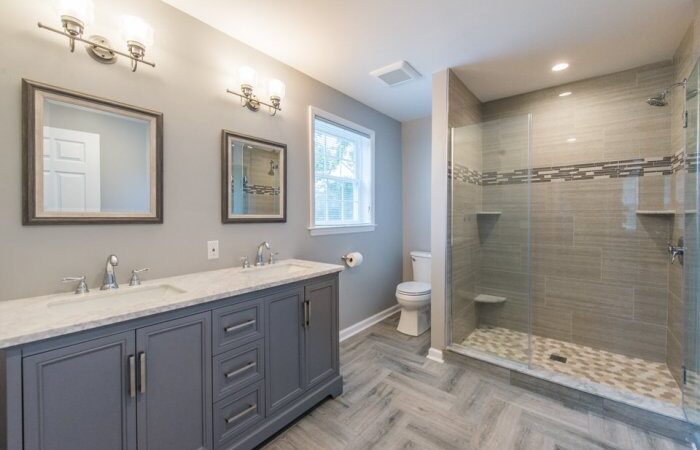
Bathroom remodel contractors play a crucial role in transforming your vision into a reality. Whether you’re dreaming of a luxurious spa-like retreat or a functional and modern space, finding the right contractor is essential for a successful project. From initial planning and design to construction and finishing touches, a skilled and experienced contractor can guide you through every step of the process, ensuring your bathroom remodel meets your expectations and budget.
This comprehensive guide will delve into the key aspects of bathroom remodeling, from understanding the basics to navigating the complexities of choosing the right contractor, designing your dream space, and addressing potential challenges. We’ll also explore sustainable practices and the value a well-executed bathroom remodel can bring to your home.
Bathroom Remodel Basics
A bathroom remodel can significantly enhance your home’s value and your daily life. It involves various stages, from planning to completion, and requires careful consideration of your budget, design preferences, and functionality requirements.
Planning a Bathroom Remodel, Bathroom remodel contractors.
Planning is crucial for a successful bathroom remodel. It ensures a smooth process, prevents costly mistakes, and helps you achieve your desired outcome.
- Define Your Goals and Scope: Clearly define the scope of your remodel, including the specific areas you want to renovate and the desired functionality. For example, do you want to simply update fixtures or completely redesign the layout?
- Establish a Budget: Determine a realistic budget for your project, considering all aspects, such as materials, labor, permits, and unexpected expenses.
- Gather Inspiration: Explore design ideas and gather inspiration from magazines, websites, and showrooms. Create a mood board or design sketches to visualize your vision.
- Measure and Plan Layout: Carefully measure your existing bathroom and create a detailed floor plan. This will help you determine the feasibility of your desired layout and identify potential challenges.
- Choose Materials and Fixtures: Select materials and fixtures that meet your aesthetic preferences, functionality requirements, and budget. Consider factors like durability, water resistance, and style.
- Research and Select Contractors: Interview multiple contractors, and review their experience, portfolio, and references. Choose a reputable and experienced contractor who understands your vision and budget.
Budgeting and Financing a Bathroom Remodel
Budgeting is essential for managing the costs of your bathroom remodel.
- Estimate Costs: Obtain quotes from multiple contractors and suppliers to get an accurate estimate of the project’s cost.
- Allocate Funds: Allocate funds for different aspects of the remodel, such as demolition, plumbing, electrical, materials, fixtures, and labor.
- Consider Financing Options: Explore financing options, such as home equity loans, personal loans, or credit cards, if needed.
Choosing the Right Contractor
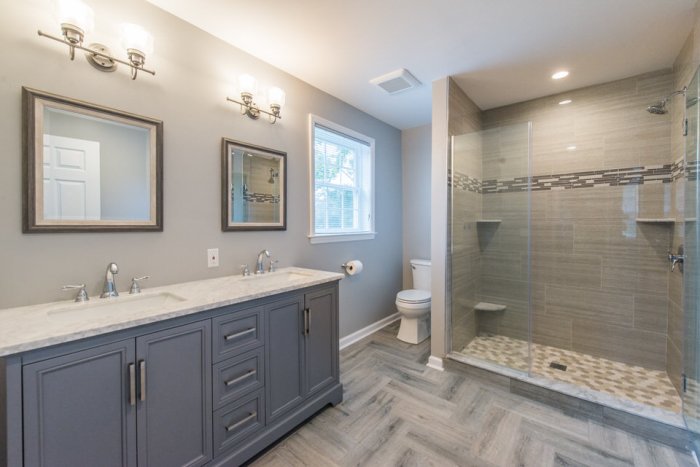
Choosing the right contractor is crucial for a successful bathroom remodel. A skilled and reliable contractor can transform your vision into reality, ensuring a beautiful and functional space. This decision should be made with careful consideration, as the right contractor can significantly impact the project’s quality, budget, and timeline.
Licensing and Insurance
Hiring a licensed and insured contractor is essential for several reasons. Licensing demonstrates that the contractor meets the minimum standards set by the state or local government, ensuring they possess the necessary knowledge and skills to perform the work safely and effectively.
Insurance protects you, the homeowner, from potential liabilities in case of accidents or injuries during the project.
Always request proof of licensing and insurance before hiring any contractor. This documentation will protect your interests and ensure the contractor is operating legally.
Types of Bathroom Remodel Contractors
Different types of contractors specialize in various aspects of bathroom remodeling. Understanding these specializations can help you choose the right professional for your project.
- General Contractors: General contractors oversee all aspects of the remodel, from demolition and plumbing to tiling and finishing. They manage subcontractors, coordinate work, and ensure the project stays on schedule and within budget. This is a good option for complex projects with multiple trades involved.
- Specialty Contractors: Specialty contractors focus on specific areas of bathroom remodeling, such as plumbing, electrical, or tile installation. Hiring specialists can be advantageous for projects requiring expertise in a particular area.
Factors to Consider When Selecting a Contractor
Several factors should be considered when choosing a bathroom remodel contractor. These factors can help you find a professional who aligns with your project needs and expectations.
- Experience: Look for a contractor with proven experience in bathroom remodeling. Inquire about their past projects, especially those similar to yours. Experience translates to expertise, efficiency, and problem-solving skills.
- Reputation: Research the contractor’s reputation by checking online reviews, testimonials, and industry associations. Positive feedback from previous clients is a good indicator of their professionalism and reliability.
- Communication: Effective communication is essential for a successful remodel. Choose a contractor who is responsive, clear, and willing to answer your questions. Open communication fosters trust and helps avoid misunderstandings.
Design Considerations
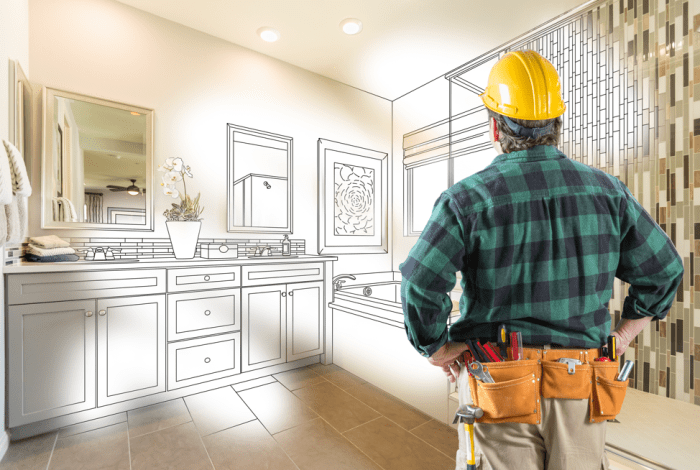
Once you’ve chosen a contractor and established a budget, it’s time to delve into the exciting world of bathroom design. This is where you can truly personalize your space and create a sanctuary that reflects your style and needs. We’ll explore popular bathroom design trends, discuss the pros and cons of various fixtures and materials, and offer tips for maximizing space and functionality.
Popular Bathroom Design Trends and Styles
Bathroom design trends are constantly evolving, influenced by factors like technological advancements, material innovations, and changing lifestyles. Understanding these trends can help you create a bathroom that feels both stylish and timeless. Here are some popular trends:
- Minimalism: Characterized by clean lines, neutral colors, and a focus on functionality. Minimalist bathrooms often feature sleek fixtures, open shelving, and a limited color palette. This style creates a sense of calm and spaciousness.
- Spa-Inspired: Designed to evoke a sense of relaxation and rejuvenation. Spa-inspired bathrooms often incorporate natural elements like wood, stone, and plants, along with luxurious amenities like soaking tubs, rainfall showerheads, and dimmable lighting.
- Industrial Chic: This style combines rustic elements with modern accents, creating a unique and edgy look. Industrial bathrooms often feature exposed brick walls, metal accents, and vintage-inspired fixtures.
- Contemporary: Contemporary bathrooms are characterized by bold colors, geometric shapes, and innovative materials. They often feature sleek fixtures, statement lighting, and a focus on functionality.
Advantages and Disadvantages of Bathroom Fixtures and Materials
Choosing the right fixtures and materials for your bathroom is crucial for both aesthetics and functionality. Here’s a breakdown of some common options:
Tile
Tile is a popular choice for bathroom floors and walls due to its durability, water resistance, and versatility. It comes in a wide range of styles, colors, and materials, allowing for endless design possibilities. Here are some advantages and disadvantages:
- Advantages: Durable, water-resistant, easy to clean, versatile in style and material.
- Disadvantages: Can be expensive, grout lines require maintenance, cold to the touch.
Countertops
Countertops are a key focal point in any bathroom, so choosing the right material is important. Here are some popular options:
- Granite: Durable, scratch-resistant, heat-resistant, comes in a variety of colors and patterns. However, it can be expensive and porous, requiring sealing.
- Quartz: Non-porous, stain-resistant, durable, comes in a wide range of colors and patterns. However, it can be more expensive than laminate and may not be as heat-resistant as granite.
- Laminate: Affordable, easy to clean, comes in a variety of styles and colors. However, it is not as durable as granite or quartz and can be prone to scratches and water damage.
Vanities
Vanities provide storage and a place for your sink. They come in a variety of styles, sizes, and materials. Here are some things to consider:
- Style: Choose a vanity that complements your overall bathroom design.
- Size: Consider the size of your bathroom and the amount of storage you need.
- Material: Wood, laminate, and metal are common vanity materials. Each has its pros and cons in terms of durability, cost, and aesthetics.
Designing a Bathroom Layout that Maximizes Space and Functionality
A well-designed bathroom layout should be both functional and aesthetically pleasing. Here are some tips for maximizing space and functionality:
- Consider the flow of traffic: Ensure there is ample space for movement around fixtures and furniture.
- Maximize storage: Utilize vertical space with cabinets, shelves, and drawers. Consider built-in storage solutions to optimize space.
- Choose the right fixtures: Select fixtures that are both functional and space-saving, such as wall-mounted toilets and faucets.
- Use mirrors strategically: Mirrors can make a small bathroom feel larger by reflecting light.
- Incorporate natural light: Maximize natural light by using large windows or skylights.
Common Bathroom Remodel Challenges
Bathroom renovations, while exciting, can present unforeseen challenges. Understanding these potential issues can help you navigate the process smoothly and avoid costly delays.
Plumbing Problems
Plumbing issues are a common challenge during bathroom renovations. Old pipes can be prone to leaks, blockages, and corrosion.
- Pipe corrosion: Over time, pipes can corrode, leading to leaks and potential water damage. Replacing corroded pipes is crucial for preventing future issues.
- Pipe location: Locating pipes within walls or floors can be challenging, especially in older homes. This can lead to unexpected delays and additional costs.
- Incorrect sizing: Using incorrectly sized pipes can result in inadequate water pressure or drainage issues. It’s essential to consult a qualified plumber for accurate pipe sizing.
Structural Concerns
Structural issues can arise during a bathroom remodel, particularly when modifying walls or adding new fixtures.
- Load-bearing walls: Removing or altering load-bearing walls requires careful planning and structural engineering expertise. This ensures the integrity of the building and prevents potential collapse.
- Floor joist issues: Outdated or weakened floor joists can pose a risk to the stability of the bathroom floor. Reinforcing or replacing them is crucial for safety and long-term durability.
- Water damage: Existing water damage can compromise the structural integrity of the bathroom. It’s important to address any water damage before proceeding with the renovation.
Communication Breakdowns
Clear and consistent communication is vital for a successful bathroom remodel. Misunderstandings or lack of communication can lead to delays, frustration, and costly rework.
“Effective communication is key to a smooth renovation process.”
- Project scope: Clearly define the project scope and expectations upfront. This includes details about materials, finishes, fixtures, and budget.
- Regular updates: Establish a schedule for regular updates with the contractor. This keeps you informed about progress, potential issues, and any necessary adjustments.
- Addressing concerns: Promptly address any concerns or questions that arise. Don’t hesitate to communicate openly with the contractor to ensure a positive outcome.
The Importance of Permits and Inspections
Obtaining the necessary permits and passing inspections are crucial steps in any bathroom remodel project. These steps ensure that your project meets local building codes, promotes safety, and protects your investment.
Permit Requirements
Permits are required for most bathroom remodeling projects, especially those involving structural changes, plumbing, electrical work, or changes to the ventilation system. They ensure that your project complies with local building codes, which are designed to safeguard public health and safety.
Inspection Process
The inspection process typically involves a building inspector visiting your property to verify that the work meets the approved plans and local building codes. Inspections are usually required at various stages of the project, such as:
- Rough-in inspection: This inspection occurs after the plumbing, electrical, and ventilation systems are installed but before the walls are closed in. The inspector verifies that these systems are properly installed and meet code requirements.
- Final inspection: This inspection takes place once all work is complete, including finishes and fixtures. The inspector verifies that the bathroom meets all code requirements and is safe for use.
Ensuring Compliance
To ensure your project complies with local building codes and avoid delays or additional costs, consider the following tips:
- Obtain all necessary permits before starting work. Contact your local building department to determine the specific permits required for your project.
- Work with a licensed and insured contractor. Licensed contractors are familiar with local building codes and can ensure your project meets all requirements.
- Keep detailed records of all work performed. This includes receipts for materials, permits, and inspection reports. These records can be helpful in case of disputes or future inspections.
- Schedule inspections promptly. Contact your local building department to schedule inspections as soon as each stage of work is complete. Delays can lead to additional fees or penalties.
“Obtaining permits and passing inspections may seem like an extra step, but it’s essential for a safe and successful bathroom remodel.”
Sustainable Bathroom Remodel Practices
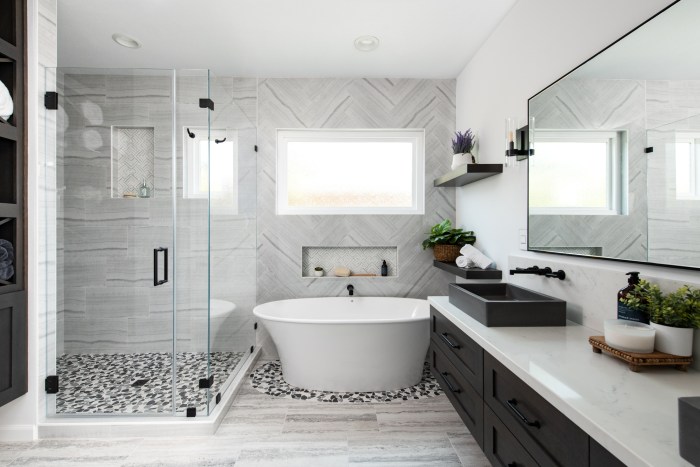
Embracing sustainability in your bathroom remodel goes beyond aesthetics; it’s about making environmentally conscious choices that benefit both the planet and your wallet. By incorporating sustainable practices, you can create a bathroom that’s both stylish and eco-friendly, minimizing your environmental footprint while enjoying long-term cost savings.
Environmentally Friendly Materials and Fixtures
Sustainable bathroom materials and fixtures play a crucial role in reducing the environmental impact of your remodel. These options minimize resource depletion and pollution while ensuring durability and longevity.
- Recycled Materials: Opt for materials made from recycled content, such as recycled glass tiles, reclaimed wood vanities, or countertops crafted from recycled paper or plastic. These materials reduce waste and conserve natural resources.
- Sustainable Wood: Choose sustainably harvested wood for vanities, cabinets, and flooring. Look for certifications like Forest Stewardship Council (FSC) or Sustainable Forestry Initiative (SFI) to ensure the wood comes from responsibly managed forests.
- Low-VOC Paints and Finishes: Volatile organic compounds (VOCs) released from traditional paints and finishes can contribute to indoor air pollution. Choose low-VOC or zero-VOC paints and finishes to improve indoor air quality and reduce your environmental impact.
- Water-Efficient Fixtures: Installing water-efficient fixtures like low-flow showerheads, toilets, and faucets can significantly reduce water consumption. Look for fixtures with the WaterSense label, indicating they meet EPA water efficiency standards.
- Energy-Efficient Lighting: Replace traditional incandescent bulbs with energy-efficient LED or CFL bulbs. These options use less energy, reducing your electricity consumption and lowering your energy bills.
Reducing Water and Energy Consumption
Implementing water and energy-saving strategies in your bathroom can significantly reduce your environmental footprint and lower your utility bills.
- Water-Saving Showerheads: Installing low-flow showerheads can reduce water consumption by up to 40% without sacrificing water pressure.
- Dual-Flush Toilets: Opt for dual-flush toilets that offer two flush options, allowing you to use less water for liquid waste and more for solid waste.
- Low-Flow Faucets: Install low-flow faucets in sinks and tubs to reduce water usage while maintaining functionality.
- Water-Saving Shower Systems: Consider installing a water-saving shower system that incorporates a low-flow showerhead, a water-saving valve, and a recirculation pump to reduce water waste and energy consumption.
- Smart Thermostats: Install a smart thermostat to regulate water temperature automatically, preventing unnecessary energy waste.
- Energy-Efficient Lighting: Choose LED or CFL bulbs for bathroom lighting, as they consume less energy than traditional incandescent bulbs.
- Motion-Sensing Lights: Install motion-sensing lights in areas like the bathroom to ensure lights are only on when needed, reducing energy waste.
Benefits of Sustainable Bathroom Remodels
Incorporating sustainable practices into your bathroom remodel offers numerous benefits, both for the environment and for your wallet.
- Reduced Environmental Impact: Sustainable bathroom practices minimize resource depletion, reduce pollution, and contribute to a healthier planet.
- Lower Utility Bills: Water-efficient fixtures and energy-saving measures can significantly reduce your water and energy consumption, leading to lower utility bills.
- Improved Indoor Air Quality: Choosing low-VOC paints and finishes can improve indoor air quality, creating a healthier and more comfortable living space.
- Increased Property Value: Sustainable bathroom features can enhance your home’s value and appeal to potential buyers, making it more attractive and desirable.
- Peace of Mind: Knowing that your bathroom remodel is environmentally friendly and sustainable can provide peace of mind and contribute to a sense of well-being.
The Value of a Bathroom Remodel
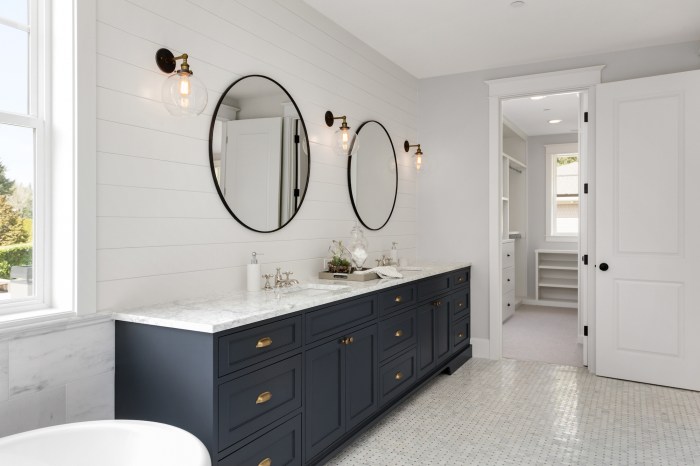
A bathroom remodel can be a significant investment, but it can also be a smart one, adding value to your home and enhancing your daily life. By updating your bathroom, you can create a more functional, stylish, and enjoyable space that increases your home’s appeal to potential buyers and enhances your quality of life.
Increasing Home Value
A well-executed bathroom remodel can significantly increase your home’s value. According to the National Association of Realtors, a bathroom remodel can recoup up to 70% of its cost at resale. This makes it one of the most profitable home improvement projects.
Maximizing Return on Investment
Several factors can influence the return on investment for a bathroom remodel. Here are some tips to maximize your return:
- Focus on Functionality: Prioritize updates that enhance functionality, such as adding storage, upgrading fixtures, and improving accessibility.
- Choose Neutral Colors and Finishes: Opt for neutral colors and finishes that appeal to a wide range of buyers. This makes your bathroom more marketable and less likely to turn off potential buyers.
- Don’t Overspend: While a high-end remodel can add value, it’s important to stay within a budget that makes financial sense. Consider your home’s overall value and the market conditions in your area when making decisions.
- Invest in Quality Materials: Choosing quality materials, such as durable countertops and flooring, will add value and longevity to your remodel.
Long-Term Benefits
Investing in a well-designed bathroom offers long-term benefits beyond just increasing your home’s value:
- Enhanced Quality of Life: A well-designed bathroom can create a more relaxing and enjoyable space, improving your overall well-being.
- Increased Efficiency: Upgrading fixtures, such as low-flow showerheads and toilets, can save water and energy, reducing your utility bills.
- Improved Accessibility: If you plan to stay in your home for the long term, consider making your bathroom more accessible with features like walk-in showers and grab bars. This can make your home more comfortable and safe as you age.
Last Point: Bathroom Remodel Contractors
Ultimately, a successful bathroom remodel is a collaborative effort between you and your contractor. By understanding the process, carefully selecting a qualified professional, and actively participating in the design and construction phases, you can transform your bathroom into a haven that reflects your style and enhances your daily life.
Remember, a well-planned and executed bathroom remodel can be a rewarding investment that increases your home’s value and creates a space you’ll love for years to come.
Comments are closed.